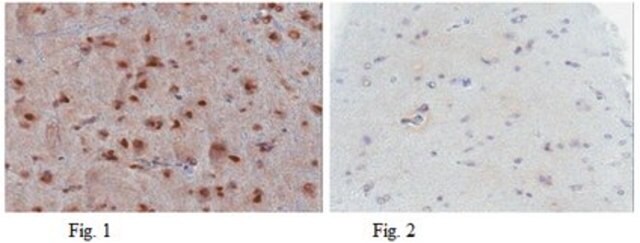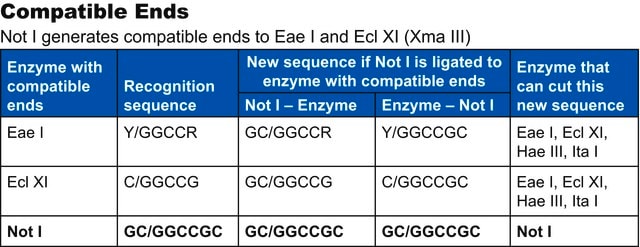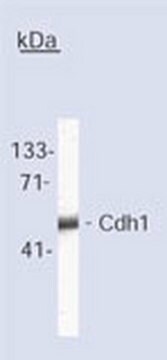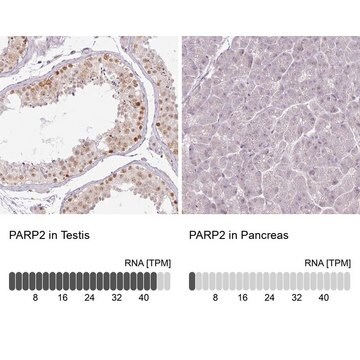R8381
Dpn I from Diplococcus pneumoniae
Restriction Enzyme
Faça loginpara ver os preços organizacionais e de contrato
About This Item
Número CAS:
Número MDL:
Código UNSPSC:
12352204
Produtos recomendados
grau
for molecular biology
Formulário
buffered aqueous glycerol solution
concentração
10,000 units/mL
Condições de expedição
wet ice
temperatura de armazenamento
−20°C
Especificidade
Recognition sequence: 5′-GmA/TC-3′
Ligation and recutting results: After 2-10-fold Dpn I overdigestion of 1 μg pBR322 DNA substrate, results in 100% cutting, >30% of fragments can be ligated, and >90% recut.
Heat inactivation: 75 °C for 15 minutes.
Ligation and recutting results: After 2-10-fold Dpn I overdigestion of 1 μg pBR322 DNA substrate, results in 100% cutting, >30% of fragments can be ligated, and >90% recut.
Heat inactivation: 75 °C for 15 minutes.
Aplicação
DpnI is a restriction endonuclease that is used in molecular biological applications to cleave the recognition sequence 5′-GmA/TC-3′, generating DNA framents with blunt ends.
Outras notas
Supplied with 10x Restriction Enzyme Buffer SA (B7531).
Comment: Since Dpn I will completely cleave only fully methylated pBR322 DNA, cleavage of 95% or more is considered complete digestion.
forma física
Solution in 10 mM Tris-HCl, pH 8.0, 400 mM NaCl, 0.1 mM EDTA, 1 mM dithiothreitol, 200 μg/ml BSA, 50% glycerol (v/v) at 4 °C
produto relacionado
tampão de incubação
Nº do produto
Descrição
Preços
Código de classe de armazenamento
10 - Combustible liquids
Classe de risco de água (WGK)
WGK 1
Ponto de fulgor (°F)
Not applicable
Ponto de fulgor (°C)
Not applicable
Escolha uma das versões mais recentes:
Já possui este produto?
Encontre a documentação dos produtos que você adquiriu recentemente na biblioteca de documentos.
S Lacks et al.
The Journal of biological chemistry, 250(11), 4060-4066 (1975-06-10)
A deoxyribonuclease specific for methylated DNA was isolated from Diplococcus pneumoniae. The enzyme, an endonuclease, degrades DNA for Escherichia coli to fragments of average molecular weight about half a million; it forms discrete fragments from phage lambda DNA. Methyl-deficient E.
Min Ju et al.
The Journal of biological chemistry, 278(15), 12769-12778 (2003-02-01)
The human and rat forms of the Kv2.1 channel have identical amino acids over the membrane-spanning regions and differ only in the N- and C-terminal intracellular regions. Rat Kv2.1 activates much faster than human Kv2.1. Here we have studied the
K Alheim et al.
Journal of molecular endocrinology, 30(3), 359-368 (2003-06-07)
Glucocorticoids are known regulators of the cell cycle, normally exerting an anti-proliferative effect. We have previously shown that glucocorticoids stimulate expression of p57(Kip2), a member of the Cip/Kip family of cyclin-dependent kinase inhibitors which, in some cell types, may account
C Kessler et al.
Gene, 92(1-2), 1-248 (1990-08-16)
The properties and sources of all known class-I, class-II and class-III restriction endonucleases (ENases) and DNA modification methyltransferases (MTases) are listed and newly subclassified according to their sequence specificity. In addition, the enzymes are distinguished in a novel manner according
Cong Zhu et al.
Nucleic acids research, 41(4), 2455-2465 (2013-01-11)
Zinc-finger nucleases (ZFNs) have been used for genome engineering in a wide variety of organisms; however, it remains challenging to design effective ZFNs for many genomic sequences using publicly available zinc-finger modules. This limitation is in part because of potential
Nossa equipe de cientistas tem experiência em todas as áreas de pesquisa, incluindo Life Sciences, ciência de materiais, síntese química, cromatografia, química analítica e muitas outras.
Entre em contato com a assistência técnica








